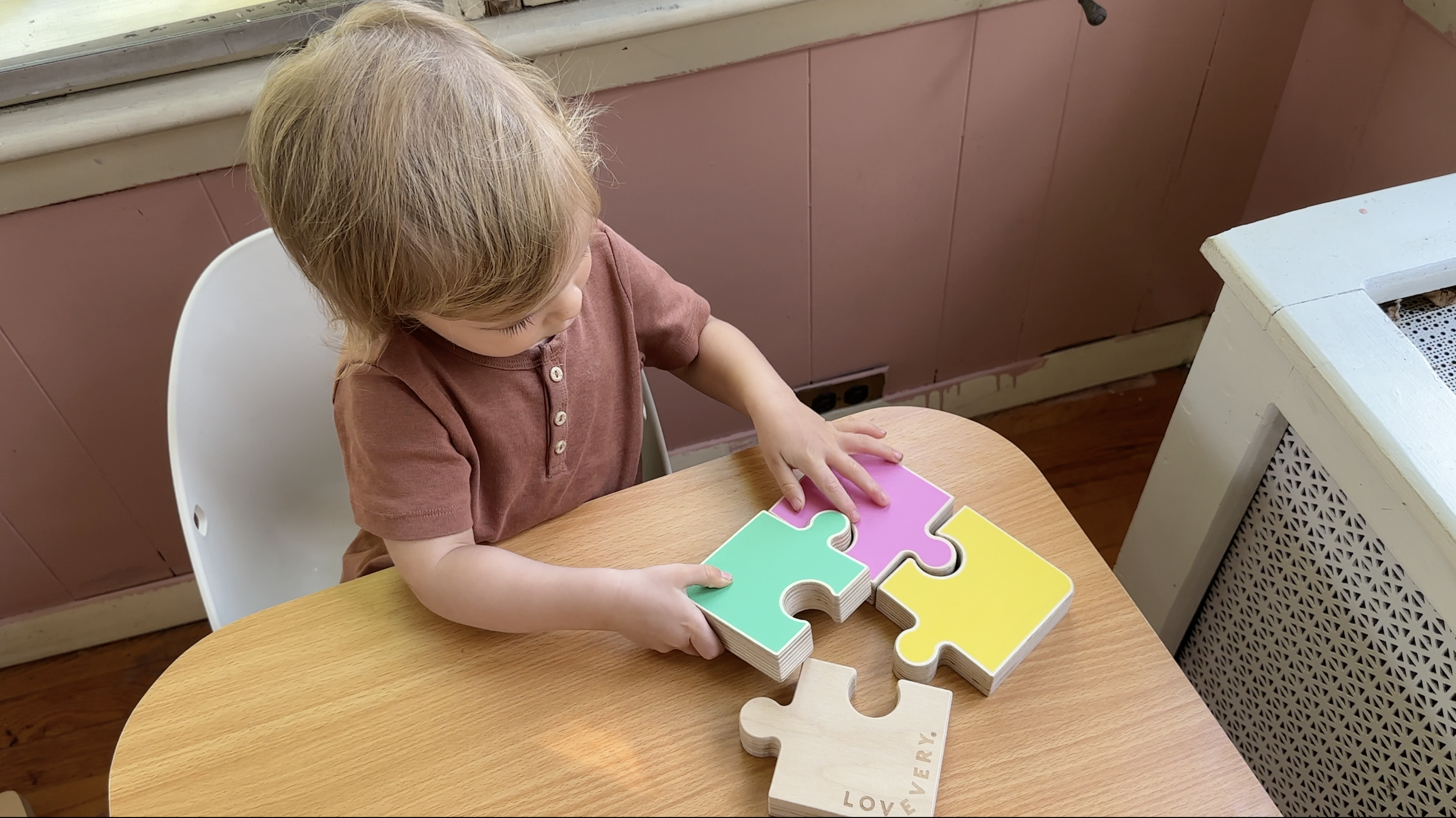Introducing Puzzles to Your Toddler: Jigsaw Puzzles
This post may contain affiliate links, which means I may earn a small commission if you buy through my link but does not change your price.
Are you interested in introducing jigsaw puzzles but not sure where to start? Puzzles are such a great activity for toddlers because they develop their concentration, problem-solving skills, and fine motor skills. Puzzles are a wonderful and affordable addition to a Montessori home as they can often be purchased for inexpensive or secondhand. This post covers how we introduced jigsaw puzzles from the simplest 2-piece ones to 48-piece puzzles in our Montessori home. If you are interested in our first introduction to Montessori puzzles, check out this blog post.
Our first jigsaw was this chunky jigsaw. It looks pretty simple but it does have a bit of a challenge since there are two sides to it and it isn’t clear which way is up when you’re working on a given side (both sides have color). He was not a huge fan until later once it was pretty easy for him after he had more jigsaw experience. I think this puzzle would have been better with color only on one side. He was able to get it a bit when we first introduced around 21 months but he wasn’t generally drawn to it.
The first jigsaw he actually showed interest in was a 2-piece baby and adult animal matching puzzle. If your child is ready for baby and adult animal matching, this is great. Generally, a child is ready for that once they have done object-to-picture matching and picture-to-picture matching with exact images. When we introduced this I had already introduced picture-to-picture matching with non-exact images. He loved that and that led to his interest in this puzzle. I love the real photos on this puzzle. Another perk is you can vary the challenge a lot. Matching a calf and a cow is a lot easier, for example, than a tadpole and a frog. I started easy and with only a few. I added more and more of the complex ones as his abilities grew. Now he can do all of them at once and that is his preferred method.
As he got into jigsaws I also wanted to introduce some where he was completing the full picture instead of just matching. I started out with these progressive puzzles. When I first introduced he loved the two-piece one but wasn’t ready for the four-piece. After a couple of days, he had the four-piece one down and I introduced the 6-piece one and soon after the 8-piece one. I love these and felt they really helped his confidence and his puzzle-solving skills. I do wish they were more realistic and not cartoons (more Montessori-aligned as the Montessori method prefers real pictures or realistic illustrations), but that’s not the end of the world. The goal here was for him to see how smaller pieces came together to make a whole and he got that from these.
We also have these head-to-tail puzzles which are fantastic. I love that they use real images unlike the progressive set, but they are only 3 pieces and go together in a line. They are a step up from the baby and adult animal matching, but simpler than the 4-piece progressive puzzle because it is fewer pieces and in a line rather than needing to match multiple sides. We introduced these a bit late, honestly, and they were kind of easy for him. I had already introduced the progressive puzzles at this point. He did still love them though and I make them more challenging by letting him do the full set.
The next step in his puzzle progression was a 12-piece Melissa and Doug puzzle. I chose these because I like the sturdiness of the wood and he is interested in vehicles. We started with the fire truck and he struggled at first but got it pretty quickly. Pieces here are much smaller and more similar than pieces in the progressive set. After that, we continued with more larger puzzles (16 and 18-piece). We introduced these magnetic jigsaw puzzles for traveling and we love them for on the airplane! In general, puzzles are a wonderful lightweight thing to pack.
At the same time as this jigsaw puzzle progression, we were also working on a much larger puzzle together: a 48-piece floor puzzle (Code Ayelet20). The one we have is the construction piece and play. Though he needed a lot of support at first I am glad we introduced it when we did. We introduced this puzzle right around his second birthday when he found it on our counter. I wasn’t quite ready to introduce it but thought why not. As with many of the other puzzles we introduced, I chose a topic he was interested in: construction. He has been OBSESSED with this puzzle. I support him through it by narrating my thought process as I do it alongside him, helping verbalize his thought process with him, helping find pieces, etc. This Youtube video covers a lot more about how I support him in doing a more challenging puzzle.
So what’s next for puzzles? I think we are going to continue getting more puzzles in the 12-48 piece range. He is gaining confidence constantly.






